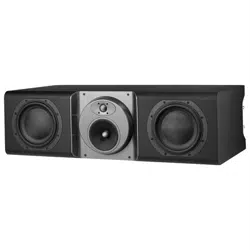Loading ...
Loading ...
Loading ...

cathode ray tube televisions or computer
monitors, audio and video tapes and swipe cards)
within 0.5m (2 feet) of the appliance. The
appliance may cause distortion of cathode ray
tube images beyond this distance. LCD and
Plasma screens are not affected.
26. Mounting – Do not place this product on an
unstable stand, tripod, bracket or table. The
product may fall causing serious injury and serious
damage. Any mounting of the product should
follow the manufacturer’s instructions.
Do not expose the device to rain, use it near water or
in damp or wet conditions, or place containers on it
containing liquids which might spill into any openings.
When setting up the device, make sure that the AC
outlet you are using is easily accessible. If some
trouble or malfunction occurs, immediately turn off the
power switch and disconnect the plug from the outlet.
Even when the power switch is turned off, electricity is
still flowing to the product at the minimum level. When
you are not using the device for a long time, make
sure to unplug the power cord from the wall AC outlet.
Environmental Information
All B&W products are designed to comply
with international directives on the
Restriction of Hazardous Substances
(RoHS) in electrical and electronic equipment and the
disposal of Waste Electrical and Electronic Equipment
(WEEE). These symbols indicate compliance and that
the products must be appropriately recycled or
processed in accordance with these directives. Consult
your local waste disposal authority for guidance.
This manual covers the CT SW10 and CT SW12
subwoofers and their matching SA1000 remote control
rack mount power amplifier.
Introduction
Dear customer,
Thank you for purchasing a Bowers and Wilkins
Custom Theatre system.
Since its foundation in 1966, the continuing
philosophy of B&W has been the quest for perfect
sound reproduction. Inspired by the company’s
founder, the late John Bowers, this quest has entailed
not only high investment in audio technology and
innovation but also an abiding appreciation of music
and movies to ensure that the technology is put to
maximum effect.
Custom Theatre speakers are specifically designed to
be built into the fabric of the listening room or into
custom furniture as part of a fully designed theatre
concept. To that end, they incorporate several features
that enable them to be adapted to a wide range of
installation conditions and deliver superb sound
quality. However, they specifically do not incorporate
features found on some other B&W products that are
not appropriate to this type of installation. An example
of such a feature would be tweeter on top, which only
operates well with a free-standing speaker.
Furthermore, because of the normal custom install
practice of hiding built-in speakers with acoustically
transparent cloth that matches the décor, all the
models except one are supplied without grilles. The
exception is the CT8 DS surround speaker, which
needs to protrude into the room in order for the side-
firing drivers to operate properly.
No matter how good the speakers themselves may
be, they will not deliver their full potential unless
properly installed. Please read through this manual
fully. It will help you optimise the performance of the
system.
B&W distributes to over 60 countries worldwide and
maintains a network of dedicated distributors who will
be able to help should you have any problems your
dealer cannot resolve.
Although the speakers are semi-active and require an
active crossover, all power amplification must be
separately sourced. Each CT8 LR, CT8 CC and CT8
DS requires two channels of power amplification, or
three if used with a CT8 SW subwoofer. This allows
the user maximum flexibility in choosing these
components.
The CT8 SW subwoofer, unlike the majority of
subwoofers currently available, does not contain its
own power amplifier and is used in a different manner
than is usual. The original concept of home theatre
based on various Dolby Digital and DTS systems
advocates five or more main channels plus a single
Low Frequency Effects (LFE) channel. The main
channels contain full range signals and the LFE
channel contains special effects up to approximately
140Hz. Recognising that many people do not want
five or more full-range speakers in one room, Dolby
Digital and DTS systems allow for the main channels
to operate with small speakers having a restricted
bass extension. The lowest frequencies from these
channels are filtered off and added to the LFE channel
to be reproduced by a subwoofer. The filter cut-off
frequency is normally set at around 80Hz, the rationale
being that sound gets progressively less directional the
lower the frequency and localisation becomes less
important. This is true to some extent, but the ears
can process directional information at very low
frequencies and the more the bass of the main
channels is extended, the more realistic the sound
stage becomes. Many high-end processors offer lower
filter cut-off frequencies for this very reason.
To preserve this directional information, a CT8 SW
may be added to each of the main channels as
desired, extending the frequency response well below
20Hz. The minimum recommended configuration is to
assign one subwoofer to each of the front left and
right channels, restoring some directional information
to the action directly on the screen and full directional
information to 2-channel audio programme. The sense
of spatial acoustic improves as more subwoofers are
added to the remaining channels. If higher sound
levels are required for larger listening environments
and greater realism, up to two subwoofers may be
added to each main channel. (It should be noted here
that the addition of more subwoofers to any single
channel requires an adjustment of the subwoofer
3
7106 CT800 manual Inside 30/9/08 9:45 Page 3
Loading ...
Loading ...
Loading ...
